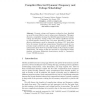Free Online Productivity Tools
i2Speak
i2Symbol
i2OCR
iTex2Img
iWeb2Print
iWeb2Shot
i2Type
iPdf2Split
iPdf2Merge
i2Bopomofo
i2Arabic
i2Style
i2Image
i2PDF
iLatex2Rtf
Sci2ools
PACS
2000
Springer
2000
Springer
Compiler-Directed Dynamic Frequency and Voltage Scheduling
Dynamic voltage and frequency scaling has been identified as one of the most effective ways to reduce power dissipation. This paper discusses a compilation strategy that identifies opportunities for dynamic voltage and frequency scaling of the CPU without significant increase in overall program execution time. The paper introduces a simple, yet effective performance model to determine an efficient CPU slow-down factor for memory bound loop computations. Simulation results of a superscalar target architecture and a program kernel compiled at different optimizations levels show the potential benefit of the proposed compiler optimization. The energy savings are reported for a hypothetical target machine with power dissipation characteristics similar to Transmeta's Crusoe TM5400 processor.
| Added | 25 Aug 2010 |
| Updated | 25 Aug 2010 |
| Type | Conference |
| Year | 2000 |
| Where | PACS |
| Authors | Chung-Hsing Hsu, Ulrich Kremer, Michael S. Hsiao |
Comments (0)

